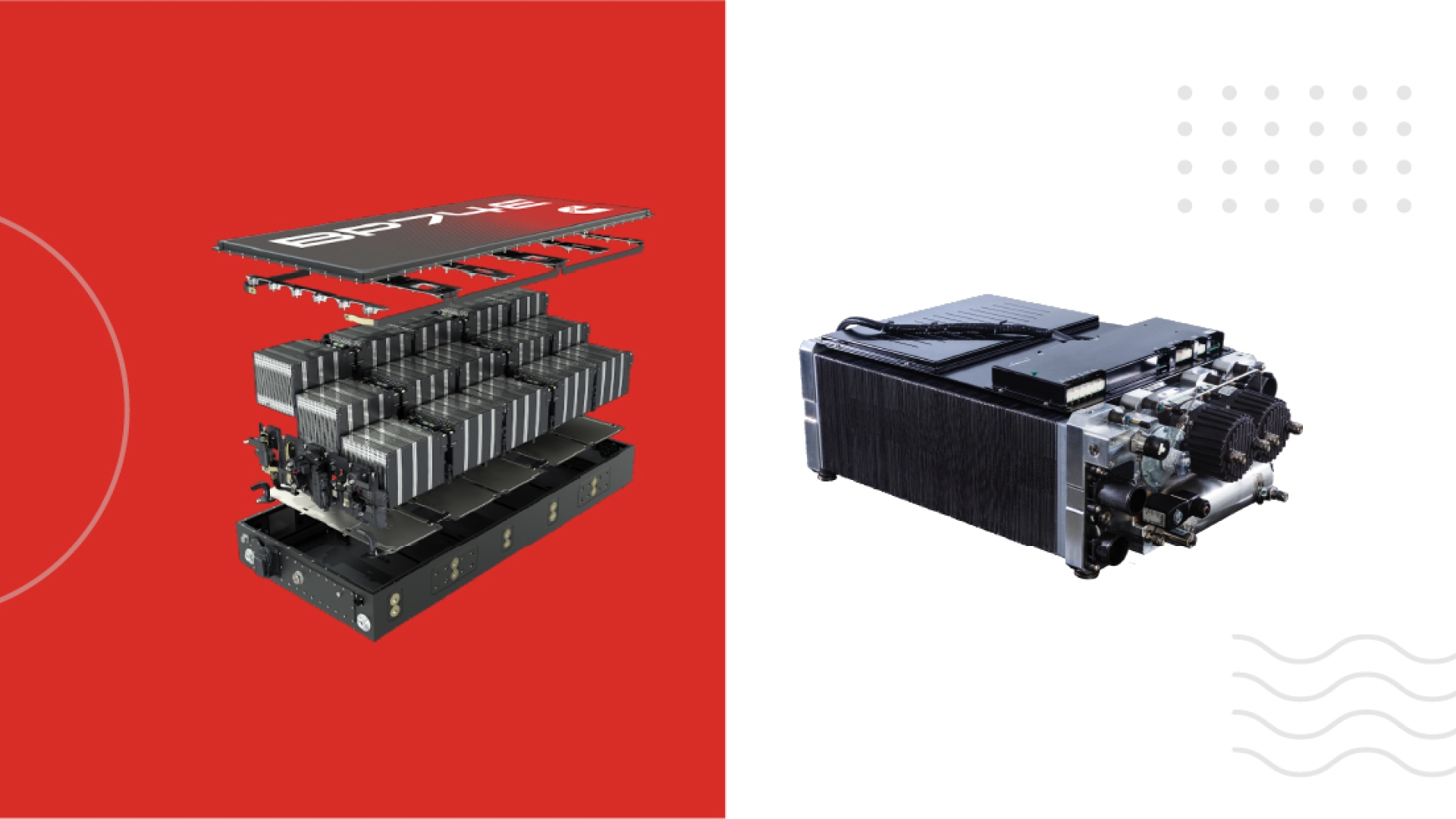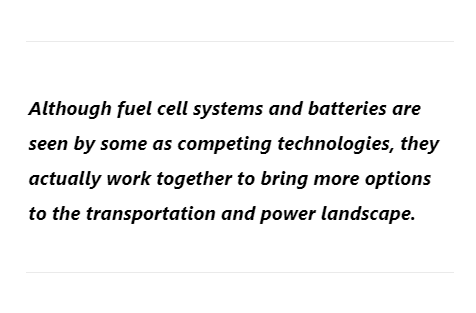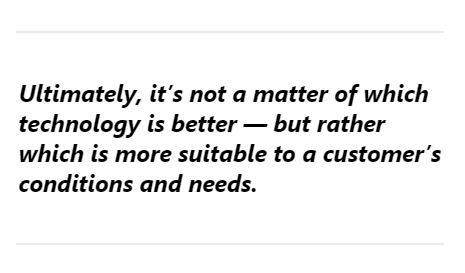배터리와 연료 전지: 차이점과 기회의 이해
제조사 Cummins Inc., 글로벌 전력 기술 리더

Energy systems across the globe are undergoing a fundamental transformation. As we continue to decrease dependence on fossil fuels, the world is demanding more diverse power solutions for our transportation needs.
Cummins is proud to be at the forefront of this transportation evolution, working with freight and bus manufacturers and operators to design and deliver scalable, zero-emission electric transportation using both cutting edge battery and hydrogen fuel cell technologies. These technologies are well-positioned to make a real change in the transportation market, but the interplay between batteries and fuel cells is often misunderstood. Read on to learn how batteries and fuel cells are better together.
INTEGRATION FOR BETTER POWER
Although fuel cell systems and batteries are seen by some as competing technologies, they actually work together to bring more options to the transportation and power landscape.
At this point, battery electric vehicles are a technology that many of us know and love. From electric package delivery vans to all-electric excavators, there are already a number of fully electric powertrain applications that are growing in popularity.

Fuel cell power systems are designed to enhance and build upon the battery and electric drive platforms that continue to grow in prominence across the globe. While each system has its own advantages, combining the emerging technologies of batteries and fuel cell can help us reduce overall carbon and increase adoption of sustainable power without compromising performance.
Fuel cell systems enhance the performance of batteries, allowing them to address distance and refueling time issues that have prohibited the adoption of battery electric vehicles for some applications. No matter how the engine and power source is configured, the battery system is and will always remain an essential piece of an electrified power solution. To this end, batteries will not be replaced by fuel cells — just enhanced by them.
Drawing from over 100 years of experience in innovating powertrains, Cummins recognizes that diverse transportation markets need diverse solutions. To help foster the transition to cleaner power, Cummins is proud to provide a variety of diverse alternative power solutions.
When considering which system is right for our customers, Cummins carefully considers range, weight, downtime, performance requirements, customer economics, and related infrastructure to provide the best options for the market — whether it’s fuel cell, battery electric or a more traditional form of power, we draw from our experience and expertise to work with customers and understand their needs.

STRENGTH IN DIFFERENTIATION
Comparing a battery and a fuel cell may be confusing as both can be used as sources of power, but in different ways. In battery electric vehicles, batteries store and deliver energy to the powertrain. A fuel cell electric vehicle generates electricity using hydrogen as fuel, and also delivers energy to the powertrain. The fuel cell can also charge the battery. The hydrogen itself acts as an energy carrier and storage device, much like a battery. However, most fuel cells configurations have limited ability to manage the powertrain energy demand in a dynamic fashion like batteries can. It’s the battery system that provides the quick response required to match the load demand from the powertrain.
Fuel cells still provide a necessary enhancement to improve many of the performance and operational gaps we see in battery electric vehicles. Also, fuel cells have the potential to better utilize renewable energy on a large scale and increase the adoption of sustainable power sources faster.
APPLICATION, PERFORMANCE AND OPERATION
In application, the largest difference between electric fuel cell and battery technology is found in their suitability for medium to heavy duty transport. When it comes to battery electric vehicles, maximum allowable axle weights constrain the number of battery packs that can be installed before compromising road weight limits and payload capacity. That’s why Cummins is continuously working to make our battery electric powertrain lighter and more efficient.
Long distances and heavy payloads require larger and heavier batteries, and larger and heavier batteries lead to diminishing performance and efficiency. In some cases, operational requirements and patterns can be effectively served by battery electric vehicles before they hit the level of diminishing efficiency, where routes and payloads are not limiting factors — such as package delivery vehicles with shorter city routes and frequent stops.
 Fuel cell electric vehicles, on the other hand, can travel farther and carry more weight than their battery electric counterparts, making them more suitable for longer hauls and heavier loads. Fuel cell electric vehicles have a much higher energy density by weight, allowing them to overcome the range and weight challenges associated with battery electric vehicles. Hydrogen tanks are also more compact and lighter than an array of fully charged batteries. Plus, adding more hydrogen tanks typically costs less than adding more batteries.
Fuel cell electric vehicles, on the other hand, can travel farther and carry more weight than their battery electric counterparts, making them more suitable for longer hauls and heavier loads. Fuel cell electric vehicles have a much higher energy density by weight, allowing them to overcome the range and weight challenges associated with battery electric vehicles. Hydrogen tanks are also more compact and lighter than an array of fully charged batteries. Plus, adding more hydrogen tanks typically costs less than adding more batteries.
Operationally, another consideration between the technologies is the impact on vehicle downtime and overall utilization. Fuel cell electric vehicles can be refueled within minutes. This results in significantly less downtime than other alternative power solutions, allowing fuel cell vehicles to be on the road just as much as conventional vehicles powered by an internal combustion engine.
Battery electric vehicles tend to be more useful when they can be recharged easily and have utilization patterns that allow for recharging downtime, such as a daily route that begins and ends at the same place, along with a designated charging depot.
The continued cost evolution of infrastructure will also play an important role in the selection of the right powertrain. High power charging solutions, such as megawatt level charging, have the potential to not only reduce the charging time from hours to minutes, but also reduce the amount of on-board battery storage needed to effectively carry out a mission. Real-time or dynamic inductive charging may also contribute to reducing the onboard battery storage requirements. Battery electric vehicles would then be able to recharge themselves while in operation.
Additionally, continued growth in the availability and distribution of hydrogen will reduce the challenges associated with hydrogen fuel costs, as well as ensuring the long-term availability of Lithium and Platinum, critical elements in batteries and hydrogen fuel cells respectively. Recycling and developing second life opportunities of these systems is also essential.
POWERING A MORE SUSTAINABLE WORLD
Ultimately, it’s not a matter of which technology is better — but rather which is more suitable to a customer’s conditions and needs. Battery electric solutions can effectively serve many transportation sectors. Where they fall short, fuel cells can help accommodate.
Cummins provides both technology options, giving our customers the power of choice backed by a century of expertise in the transportation market. Our future of transportation will be electrified, and Cummins is leading that change with a diverse portfolio of options.
저자 프로필

커민스, 글로벌 전력 기술 리더
글로벌 전력 솔루션 리더인 커민스는 부품, 엔진, 유통, 전력 시스템, Accelera by Cummins의 5개 사업부로 구성되어 있으며 글로벌 제조와 광범위한 서비스 및 지원 네트워크, 숙련된 인력 및 방대한 기술 전문성을 갖추고 있습니다. 커민스는 지속가능성에 대한 회사의 약속과 광범위한 제품 포트폴리오를 통해 고객이 에너지 전환을 성공적으로 탐색할 수 있도록 지원하는 Destination Zero 전략에 전념합니다. 커민스는 약 69,900명의 직원을 보유하고 있으며 2024년에 341억 달러의 매출로 39억 달러를 벌어들였습니다. 커민스가 어떻게 더 스마트하고 깨끗한 전력의 미래를 향해 세상을 선도하고 있는지 www.cummins.com에서 알아보세요.